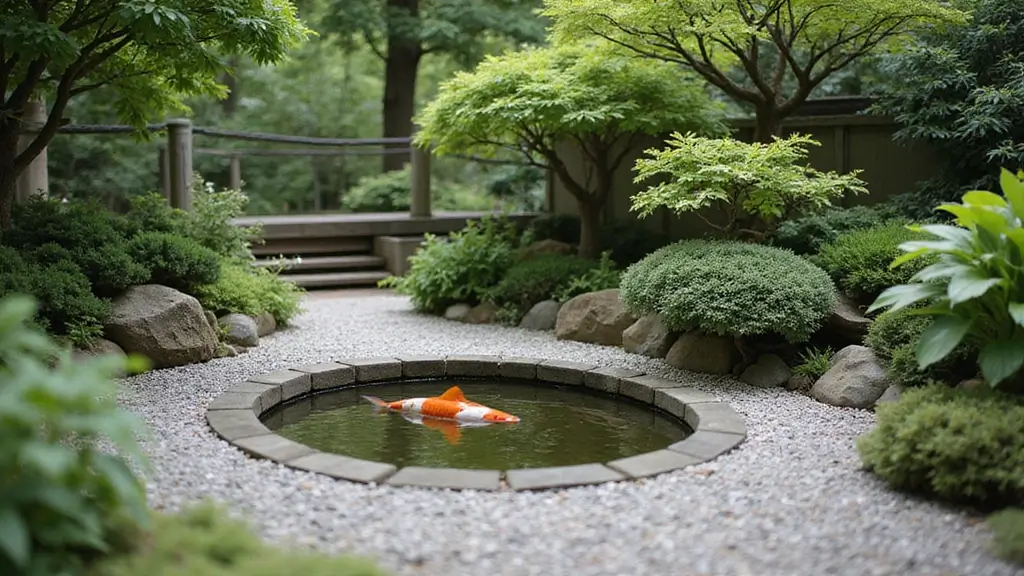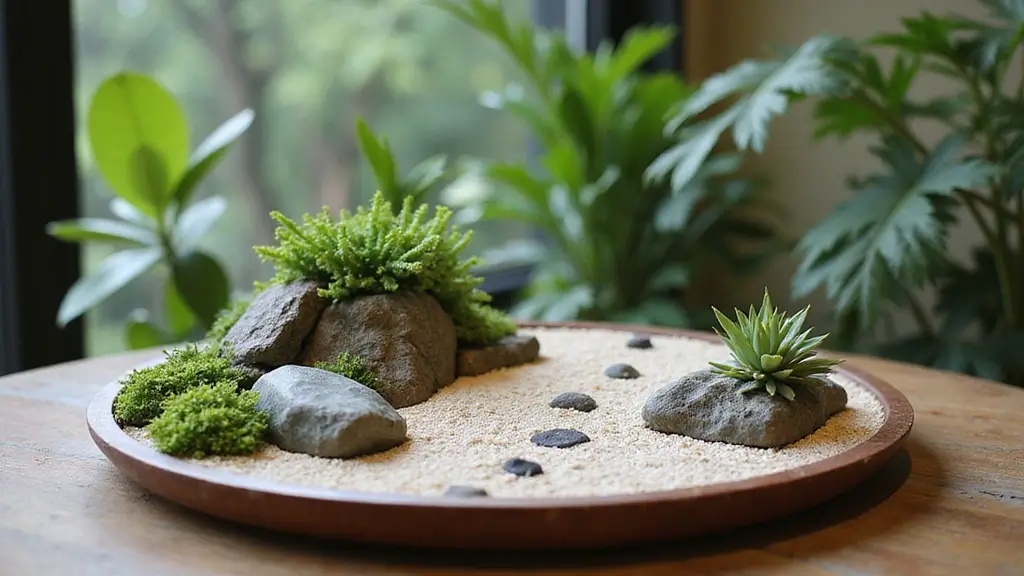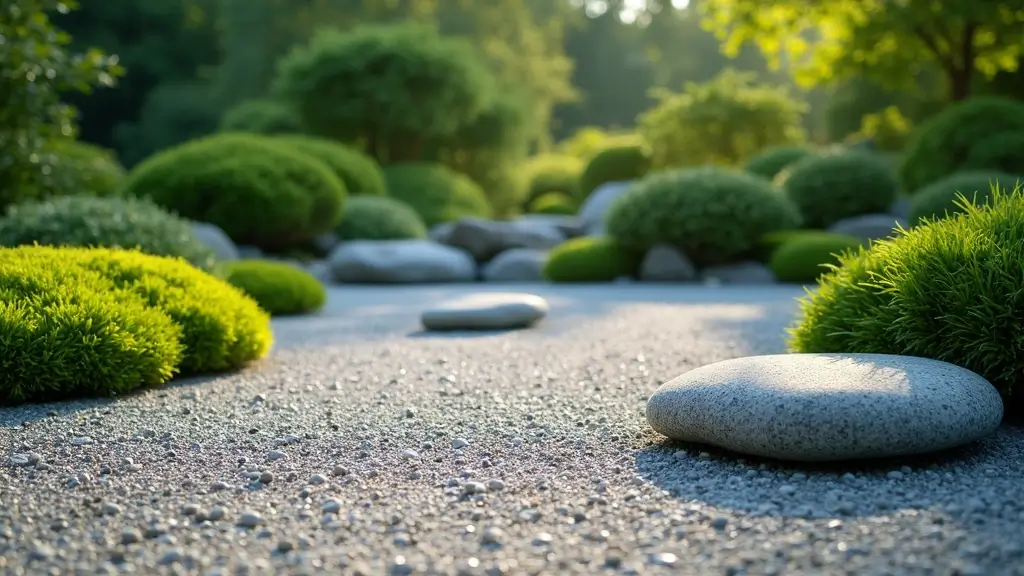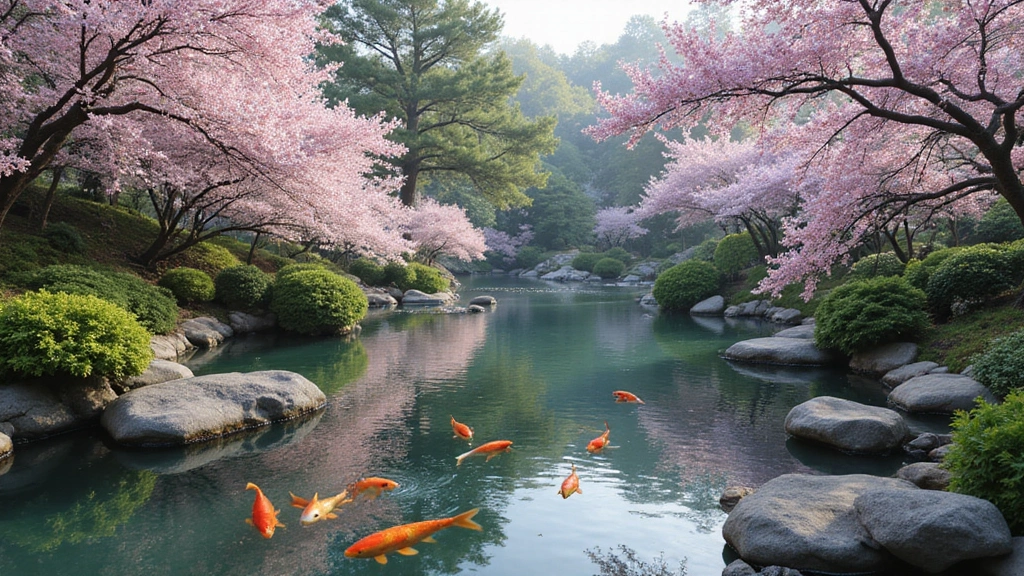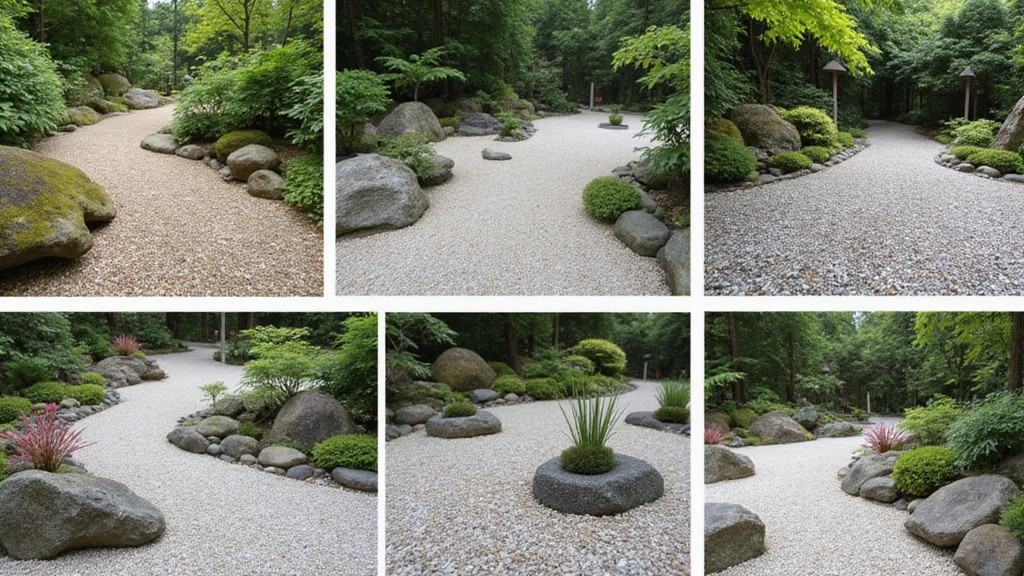Creating a small Japanese garden is not just about aesthetics; it’s about inviting peace, tranquility, and a slice of nature into your compact outdoor space. These gardens are designed to evoke feelings of serenity, balance, and harmony, making them perfect for modern urban living. From miniature koi ponds to carefully placed rocks and sand, these 26 ideas are tailored for those who want to embrace the beauty of Japanese gardening, even in tight quarters.
With a bit of planning and creativity, you can cultivate a picturesque oasis that reflects traditional Japanese design principles while fitting seamlessly into your lifestyle. So grab your gardening gloves, and let’s explore how to turn your small outdoor area into a calming retreat that’s rich in culture and style.
1. Zen Sand Garden
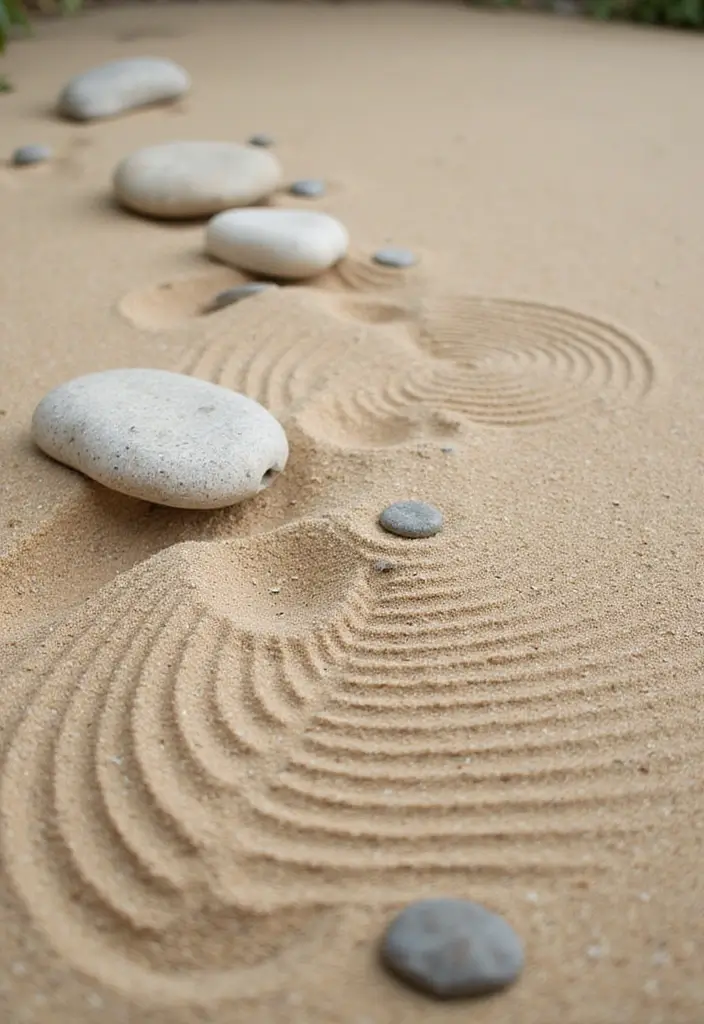
A Zen sand garden is a perfect choice for small spaces. With its minimalist design, this type of garden allows for easy maintenance and provides a space for quiet contemplation. Use fine white sand or gravel, such as RAINFLOW 15 OZ Fine White Sand for Crafts, to create a smooth surface, then add carefully raked patterns that symbolize ripples in water.
Consider incorporating flat stones or a small boulder to represent mountains or islands. These elements add depth and contrast to the sand. Additionally, introduce small plants like Altman Plants, Live Succulent Plants along the edges to soften the rigid lines of the sand. The variety in texture and color from the succulents creates a pleasing balance with the minimalist sand. Keep the garden clutter-free, allowing the simplicity to foster a calming atmosphere.
Tips:
– Regularly rake the sand to maintain the patterns.
– Choose a quiet corner of your yard to maximize peace.
– Use a wooden frame, such as the Outsunny Raised Garden Bed with Polycarbonate Greenhouse, to keep the sand contained.
A Zen sand garden doesn’t just beautify your space; it also provides a ritualistic experience every time you tend to it.
2. Koi Pond in Miniature
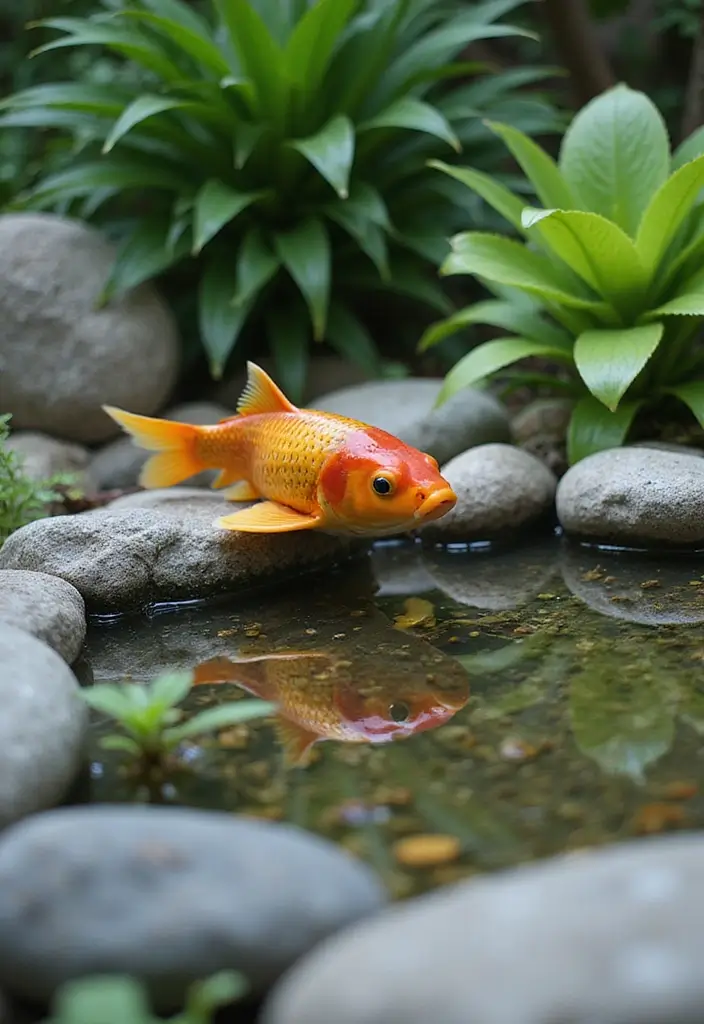
Even in limited spaces, a miniature koi pond can add a touch of elegance and tranquility to your Japanese garden. Consider using a miniature koi pond kit that fits snugly into your outdoor area. This compact option enables you to enjoy the gentle sound of water, enhancing the serene atmosphere and attracting birds and beneficial insects.
In addition to koi, including water plants like water lilies can provide both shelter and beauty. You can find suitable aquatic plants for your pond, such as the aquatic plants for ponds, which not only enhance the visual appeal of your pond but also support the ecosystem by offering habitats for fish. Surrounding the pond with smooth stones or a pebble pathway creates a naturalistic look that invites visitors to pause and enjoy the scenery.
To keep the pond clean and maintain the health of your fish, a reliable water filtration system is essential. The water filtration system for ponds helps manage water quality efficiently, ensuring a healthy environment for your koi.
Here are a few insights to keep in mind:
– Choose koi varieties that thrive in smaller habitats.
– Regularly monitor water quality to keep your pond healthy.
– Create shaded areas with small shrubs to help fish feel secure.
A beautiful koi pond not only enhances the aesthetic appeal but also provides a living ecosystem right in your backyard.
3. Stone Pathways
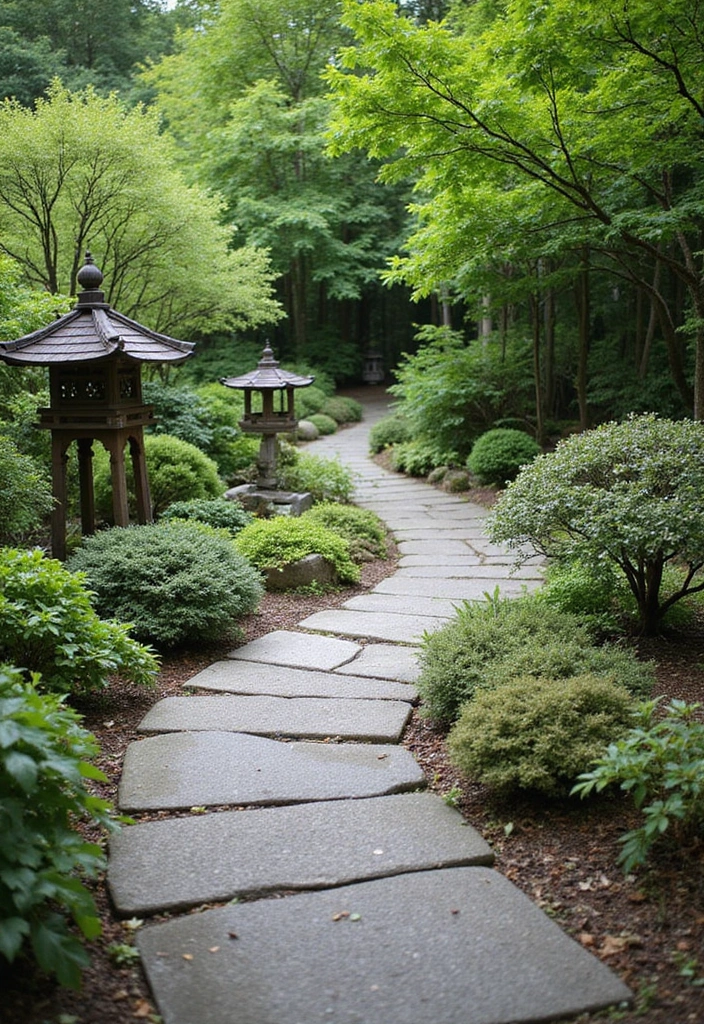
Stone pathways are a fundamental element in Japanese gardens, guiding visitors through the landscape while adding a sense of structure. In a small garden, consider using natural stone stepping stones or irregular flagstones laid out in a gentle curve to create an inviting walkway that leads to different garden areas.
To enhance the natural aesthetic, use stones that harmonize with the surroundings. Filling in the gaps with moss and low-growing plants seeds will not only create a cohesive look but also improve the visual appeal of the pathway, encouraging exploration of your compact space. Incorporating decorative outdoor lanterns for pathways can illuminate the way at night, adding to the charm and ensuring safety as you navigate through the garden.
For practical considerations, using gravel or small pebbles around the stones can improve drainage, while mixing different sizes and shapes of stones will contribute to that organic feel inherent in Japanese design. Keeping the path clear of debris will maintain a neat appearance, allowing the beauty of your stone pathways to shine. Overall, stone pathways serve not only practical purposes but also embody the beauty of Japanese design principles.
4. Bamboo Fencing
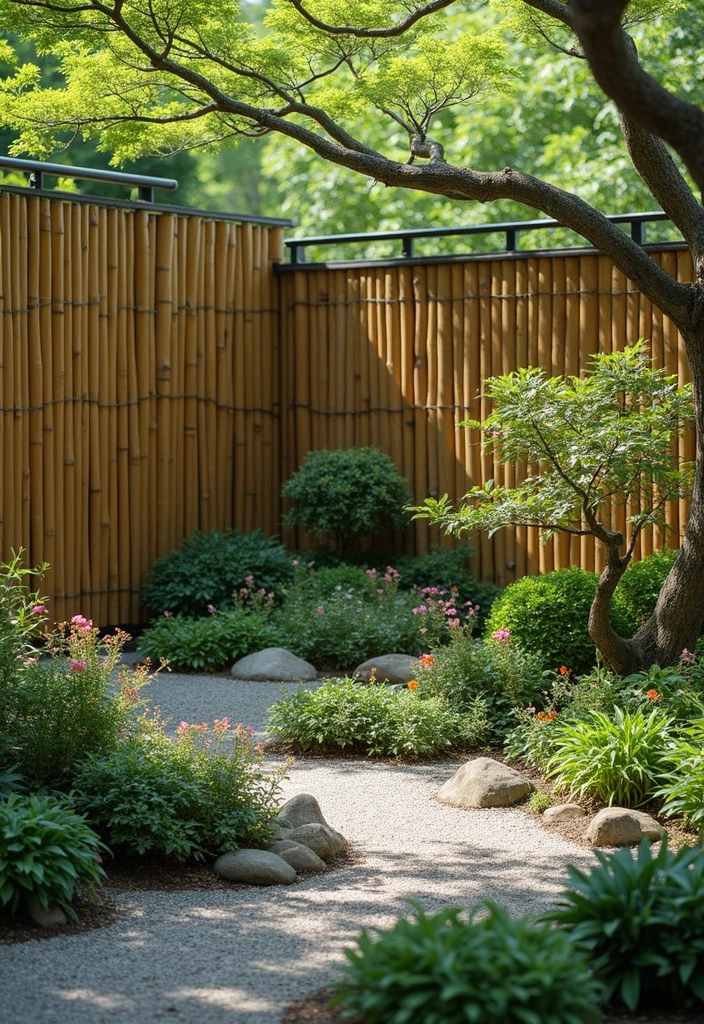
Bamboo fencing adds an authentic Japanese feel to your garden while providing privacy and structure. This lightweight but durable material can be installed easily and can be woven into various designs to match your garden’s aesthetic. For an excellent choice, consider the Backyard X-Scapes natural bamboo fencing decorative rolled fence panel. With dimensions of 0.75 in D x 6 ft H x 8 ft L, these panels make for a perfect backdrop for your plants or around your pond, adding texture and depth.
The natural look of bamboo blends beautifully with the greenery, creating a harmonious environment. Additionally, think about incorporating a bamboo garden gate for an extra touch of authenticity. This decorative outdoor privacy gate not only enhances the overall aesthetic but also serves as a functional entryway to your tranquil space. The sound of wind rustling through bamboo creates a soothing background that further enhances the calming nature of your small garden.
Tips:
– Stain the bamboo to match your garden’s color scheme.
– Use bamboo stakes for plants, which come in a set of 25 and are 4 ft long, to secure plants and create vertical gardens. These stakes are great for supporting tomatoes, beans, flowers, and other climbing plants.
– Combine bamboo with other natural materials like wood or stone for a layered effect.
Bamboo fencing not only serves practical purposes but also elevates the aesthetic experience. It brings a slice of Japan to your garden! It’s not just about privacy – it’s about creating a serene space where nature and tranquility thrive in harmony.
5. Miniature Waterfall
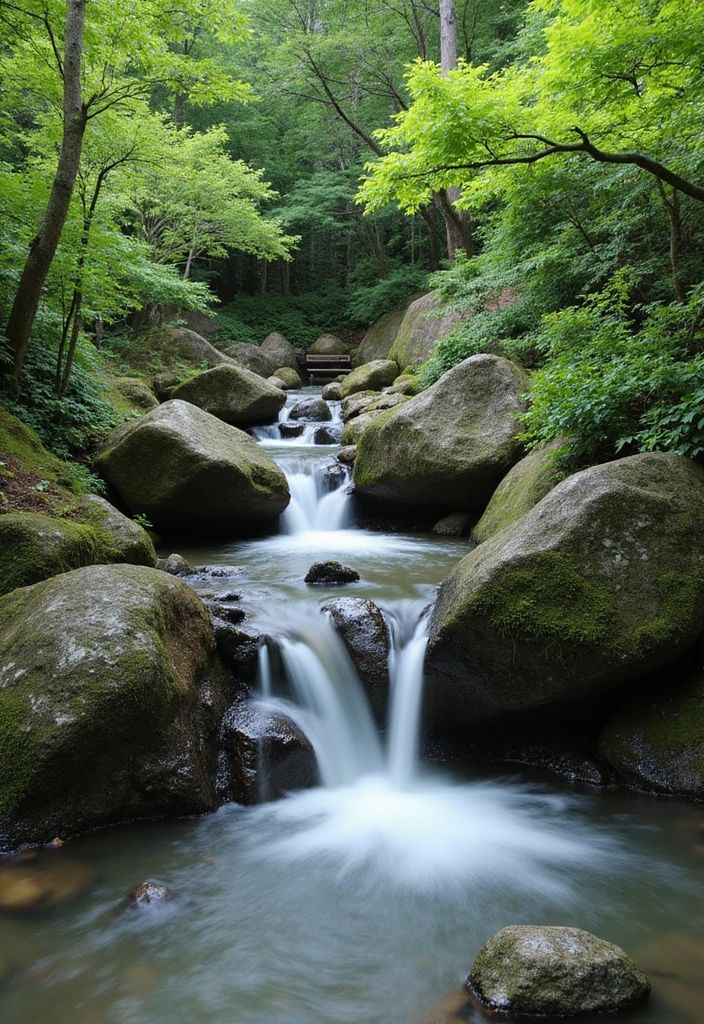
Creating a miniature waterfall can bring an enchanting element to your small Japanese garden. A small water feature with cascading water sounds can transform a simple garden into a serene retreat. To build the waterfall, use rocks of varying sizes, like the garden rocks for water feature, which offer a natural look and help create a flowing design that mimics nature.
Incorporate plants that thrive near water, such as ferns and creeping thyme, to enhance the ecosystem further. Additionally, consider using a mini water pump for a consistent water flow, ensuring your miniature waterfall remains vibrant and lively.
To make the waterfall a captivating focal point at night, opt for LED garden lights. These solar lights will highlight the waterfall, creating a magical ambiance even after the sun sets.
Keep the water clean to support aquatic life and position plants strategically to frame the waterfall beautifully. This feature not only beautifies your garden but also invites both wildlife and tranquility, making your space more dynamic.
6. Stone Lanterns
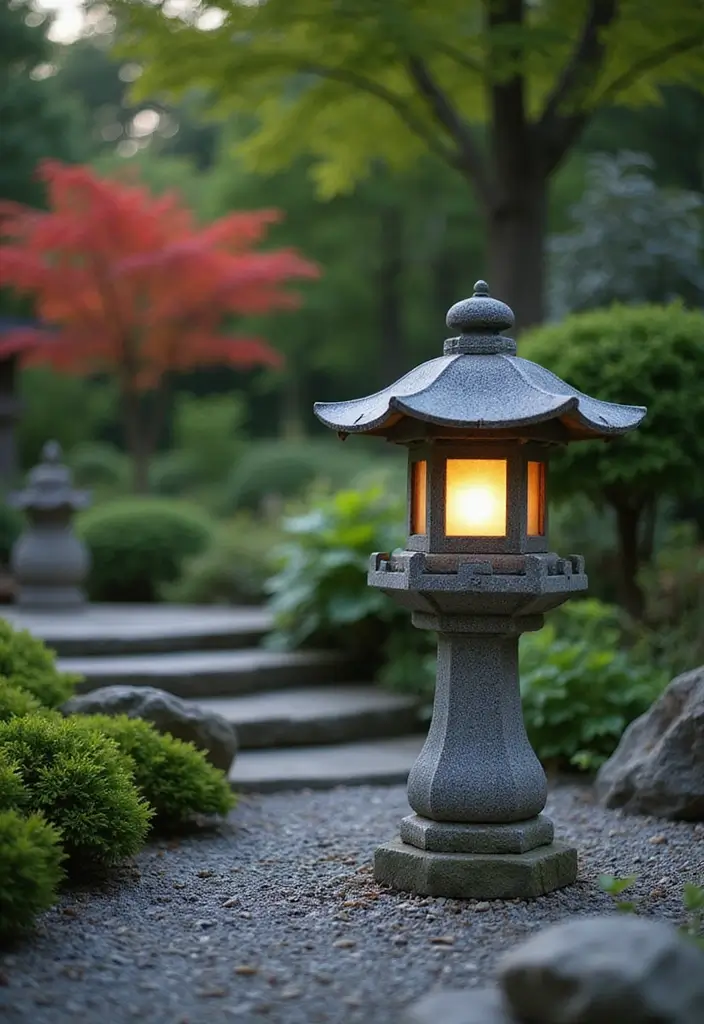
Stone lanterns are iconic in Japanese gardening, symbolizing light and guidance. They can add a charming focal point to your compact garden. Choose various styles and heights to create visual interest, and place them along pathways or near water features for maximum effect. The soft glow from lanterns at twilight can transform your garden into a magical space.
Make sure to consider the scale of your lanterns relative to your garden size. A few strategically placed lanterns can make a big impact without overwhelming the space. For instance, the natural stone lantern made of natural granite offers an authentic look that complements the traditional aesthetic of a Japanese garden. Pair it with flowering plants for a beautiful contrast, or let it stand alone against the backdrop of lush foliage.
If you’re looking for ease of installation and maintenance, consider the solar-powered garden lantern from KOOPER. These lanterns not only provide a flickering flame effect but are also waterproof, making them perfect for outdoor settings. Keeping the area around the lanterns clutter-free will enhance their beauty and ambiance.
For a cohesive look, the decorative stone lantern set adds an elegant touch with its light gray granite finish. Measuring 16 inches high, these lanterns can serve as perfect accents throughout your garden.
Stone lanterns create a peaceful ambiance while embodying traditional Japanese garden philosophy, making them a worthwhile addition to your outdoor space.
7. Pruned Bonsai Trees
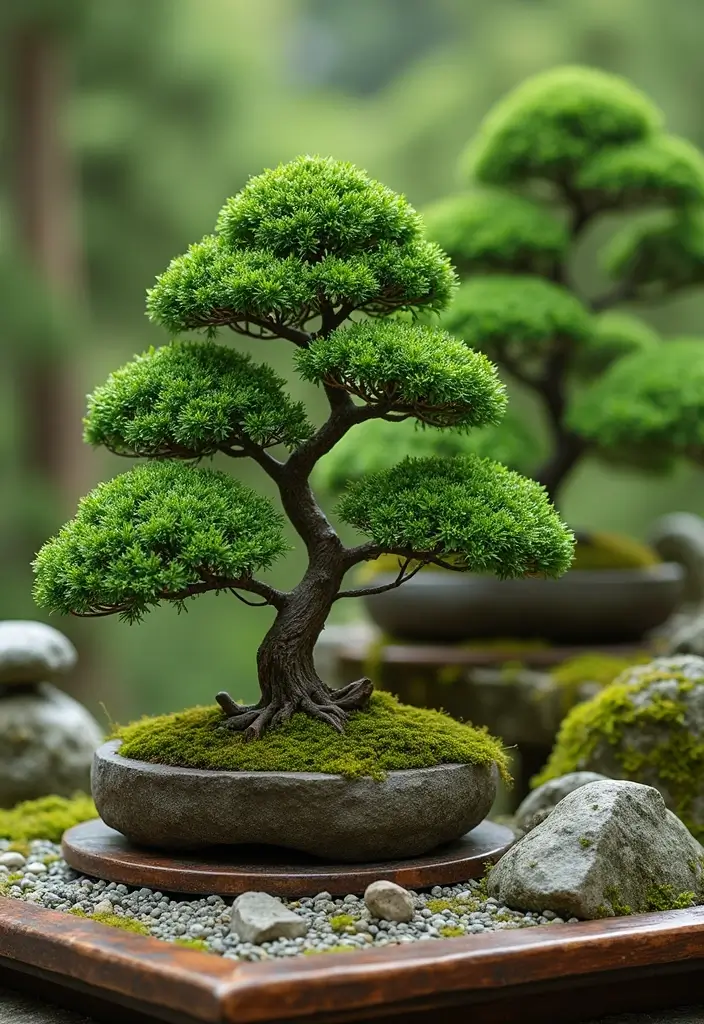
Bonsai trees encapsulate the art of Japanese gardening perfectly within small spaces. These miniaturized trees are visually stunning and serve as a representation of nature’s beauty. For those starting their bonsai journey, a bonsai tree starter kit can be an excellent choice. It includes five unique Japanese bonsai trees along with tools and planters, making it a complete indoor starter kit for growing bonsai plants.
When selecting varieties, opt for species like Juniper or Pine that can thrive in pots and are suitable for outdoor conditions. The pruning and styling of bonsai trees can be a meditative process, encouraging you to connect with nature. To maintain their shape and health, utilizing bonsai pruning shears can make a significant difference. These scissors are designed for flowers, buds, weeds, and small plants, featuring nonstick stainless steel blades that ensure a smooth cutting experience, making the pruning process more enjoyable.
Display your bonsai on a pedestal or table to highlight its elegance, and consider grouping smaller trees to create a miniature forest effect. This enhances visual interest while maximizing your limited area. Pair your bonsai with a decorative pot, such as the decorative bonsai pot that offers drainage and a stylish design. This pot not only complements your garden style but also ensures that your bonsai remains healthy.
Bonsai trees not only enhance beauty but also invite a calming routine into your gardening practice. With the right tools and care, you can create a stunning bonsai display that transforms your outdoor space.
8. Moss Gardens
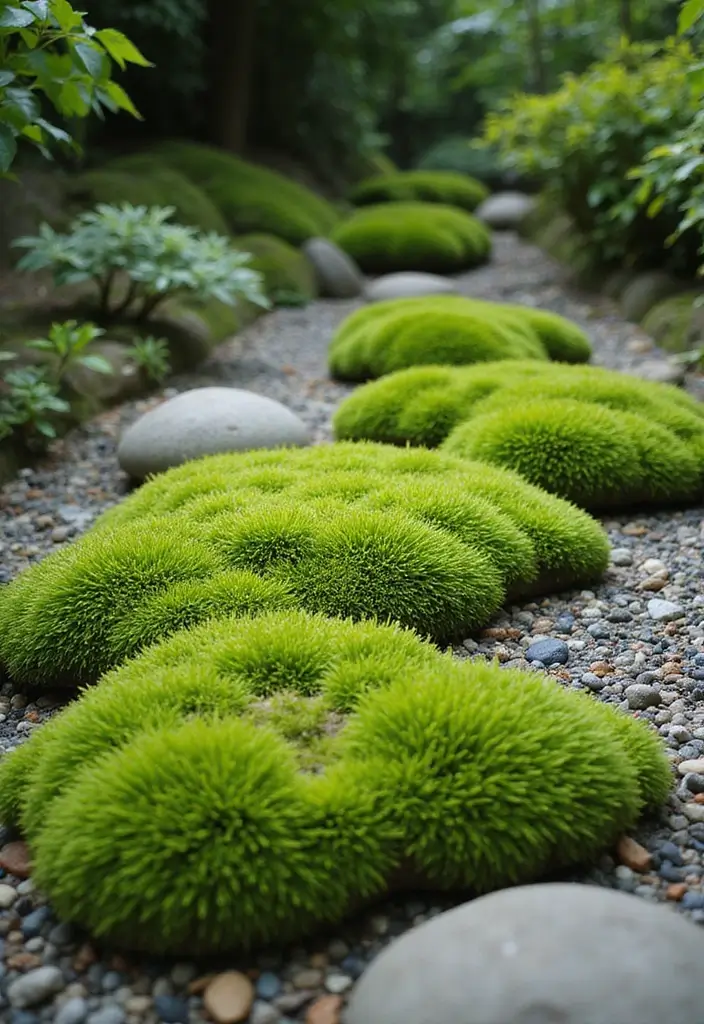
Moss is an excellent choice for creating a soft, lush carpet in small Japanese gardens. Its vibrant green hue brings life to otherwise empty spaces while requiring minimal maintenance. Moss thrives in shady areas, making it perfect for gardens that don’t receive much direct sunlight.
To get started, consider a moss starter kit, which includes a variety of mosses ideal for terrariums and bonsai. This pack allows you to create smooth patches of moss interspersed with stones or small plants for added variety. Using different varieties, such as cushion moss or sheet moss, can add texture and visual interest, encouraging a sense of peace and tranquility in your garden.
It’s crucial to keep moss moist for optimal growth, and using an moss moisture meter can help you monitor soil moisture levels easily. This tool ensures that your moss receives the right amount of water, promoting a healthy, lush appearance.
Additionally, avoid foot traffic on moss areas to preserve its integrity, and consider combining moss with ferns or dwarf plants for added depth. A lovely option for this is the dwarf fern plant, which features delicate green foliage and complements the moss beautifully.
Moss gardens not only create a calming effect but also highlight the beauty of low-maintenance gardening. With the right tools and plants, you can easily create a serene outdoor oasis.
9. Vertical Gardens

When space is limited, vertical gardens can be a fantastic solution to incorporate more greenery into your small Japanese garden. Utilizing trellises, like the Lalahoni garden trellis for climbing plants, can provide essential support for climbing vines such as wisteria or small flowering plants, creating a vertical display that adds depth and beauty to your garden.
Additionally, consider using wall-mounted planters to maximize your vertical space. These are easy to install and water, allowing you to design your own vertical garden effortlessly. Mixing various species in these planters can create a layered effect, with taller plants at the back and shorter ones at the front, drawing the eye upward and making your garden feel larger.
To keep your vertical garden healthy and hydrated, a drip irrigation kit is an excellent investment. This helps ensure your plants receive consistent moisture without the hassle of manual watering.
Vertical gardening not only saves space but also adds an element of artistry. By mixing textures and colors, you can achieve a visually appealing display that transforms even the smallest spaces into vibrant showcases of life.
10. Zen Benches
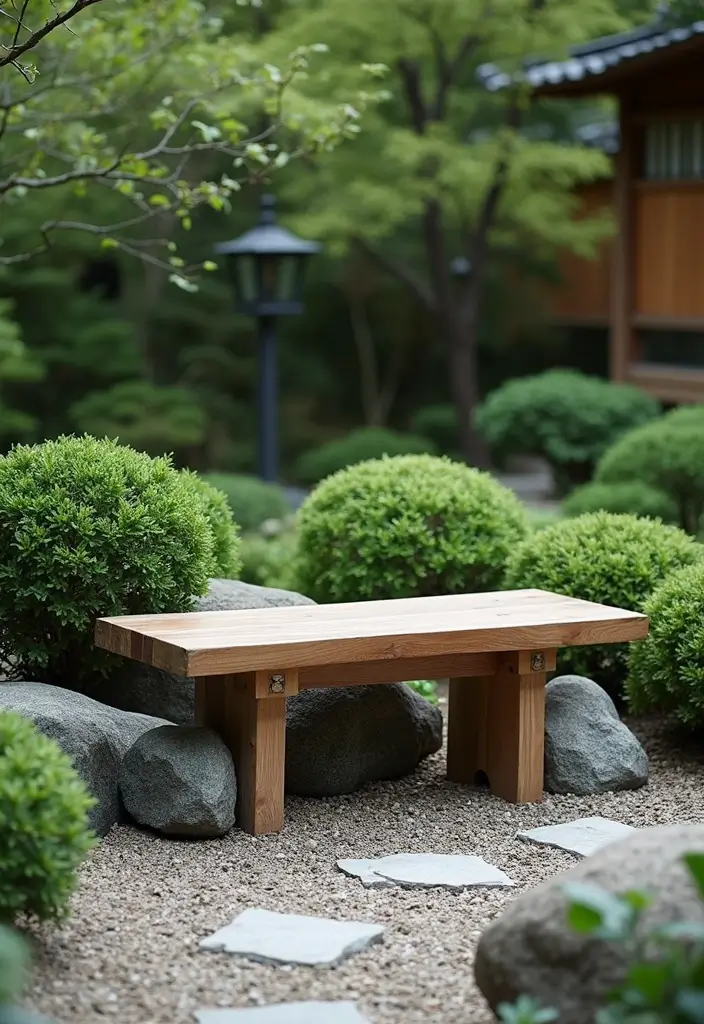
Incorporating a cozy seating area can enhance the serenity of your small Japanese garden. Zen benches, typically made from wood or stone, provide a perfect spot for relaxation and reflection. For instance, the Wood Zen Bench is crafted from sustainable acacia wood and features curved bottom edges, ensuring perfect posture for meditation or leisurely sitting. Placing the bench near a pond or under a tree creates a shaded retreat where you can enjoy the sounds of nature.
When selecting your bench, look for options that reflect the minimalist aesthetic of Japanese design, keeping lines clean and natural. The Stone Garden Bench is an excellent choice, providing a durable and stylish addition that blends seamlessly with your surroundings. Surround the seating area with soft landscaping, such as low-growing plants or decorative stones, to create an inviting atmosphere. You might even consider adding the Outdoor Cushions for Benches, which are waterproof and fade resistant, ensuring that you can enjoy comfort while sitting outdoors.
Suggestions:
– Position the bench to provide a view of your garden’s highlights.
– Opt for materials that blend seamlessly with the natural surroundings.
– Maintain the area around the bench to keep it clutter-free.
Zen benches not only enhance functionality but also invite a peaceful pause in your gardening experience.
11. Seasonal Flower Bed
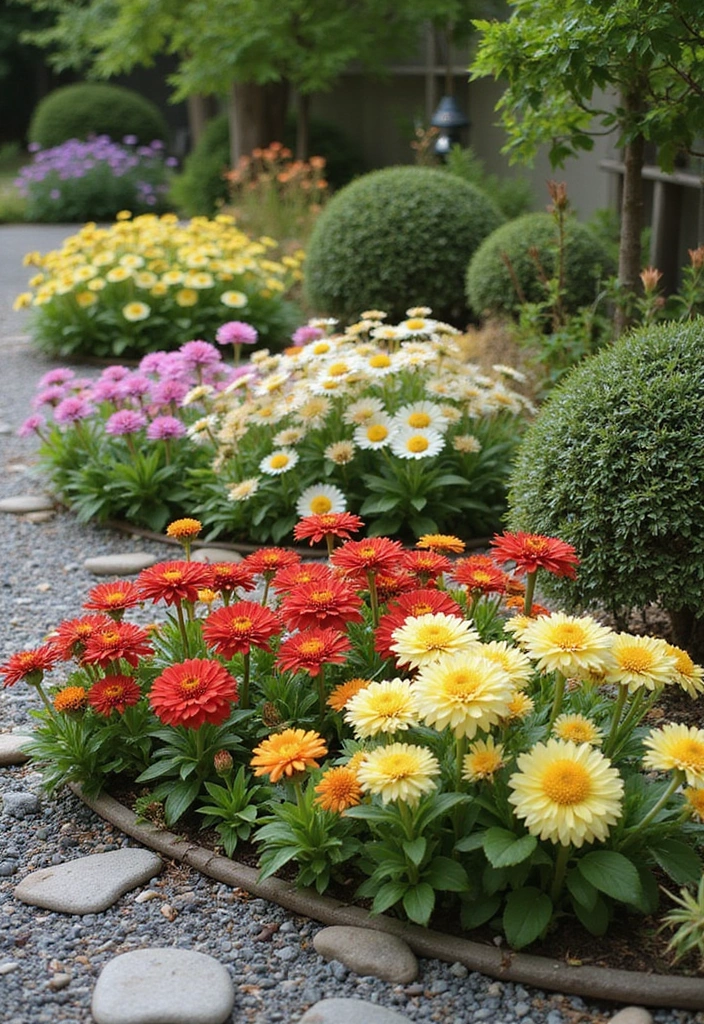
Adding a seasonal flower bed to your Japanese garden can infuse it with color and vibrancy. To ensure a lively display throughout the seasons, choose flowers that bloom at different times of the year, such as cherry blossoms in spring, irises in summer, and chrysanthemums in fall.
For a well-organized approach to garden management, consider using a garden planting guide. This planner will help you track growth, harvests, and seasonal tasks, making it easier to know when to plant and care for each variety.
When creating your flower bed, planting in layered rows not only creates a visually appealing arrangement but also simplifies maintenance. To achieve this, you might find layered planting containers especially helpful. These stackable planters are perfect for maximizing space and ensuring that your flowers are grouped by their water and light needs for easier management.
Combine flowers with traditional Japanese elements like pebbles or decorative stones to keep the design cohesive. You can enhance the aesthetic of your garden with Japanese garden decorative stones, such as a pagoda stone lantern. These elements not only add charm but also emphasize the tranquil atmosphere typical of Japanese gardens.
Additionally, consider using native plants for a more sustainable approach that supports local wildlife. Seasonal flower beds not only provide beauty but also create an inviting habitat for pollinators. Remember, with the right planning and tools, you can create a stunning seasonal flower bed that brings life and color all year round.
12. Shishi Odoshi
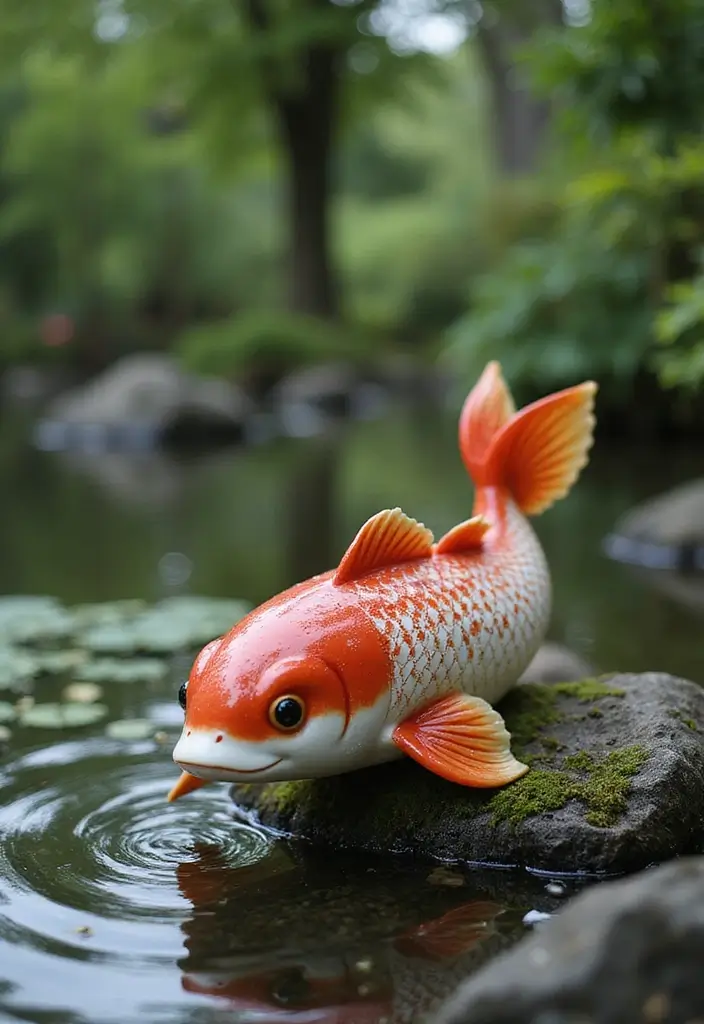
A shishi odoshi, or deer scarer, is a classic feature in Japanese gardens and can be a lovely addition to a small space. This bamboo device creates a calming sound as it tips back and forth, gently tapping on the ground to scare off pests. The soothing sound of water trickling adds to its charm.
In a compact garden, a mini shishi odoshi can be positioned near a water feature or pond. For a great solution, consider the mini shishi odoshi, which is designed specifically for smaller spaces. This not only serves its purpose but adds a unique level of interaction within your garden. The rhythmic sound enhances the tranquility and can be a wonderful focal point for visitors.
To ensure a steady water supply for your shishi odoshi and to enhance the auditory experience, you might want to incorporate a water feature like the Bamboo Accents Zen Garden water fountain kit. This adjustable spout fountain provides a consistent flow of water, which complements the bamboo’s gentle sounds beautifully.
Insights:
– Use bamboo to construct your shishi odoshi for authenticity.
– Ensure a steady water supply for continuous sound.
– Position it smartly to maximize its auditory effect.
A shishi odoshi not only serves a functional purpose but also enriches the sensory experience of your garden. Embrace tranquility with the gentle sound of bamboo and water, turning your compact space into a peaceful retreat!
13. Japanese Maples
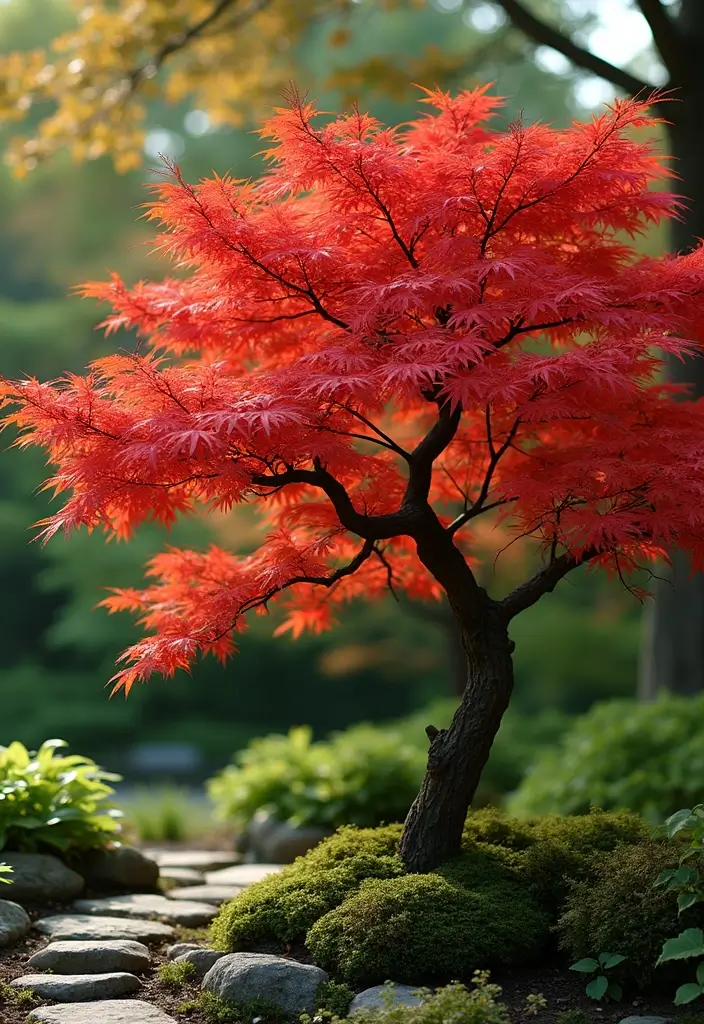
Japanese maples are iconic and can be a stunning focal point in your small garden. These trees vary in size and shape, making them suitable for a range of compact gardens. Their vibrant foliage changes with the seasons, providing visual interest throughout the year.
Consider planting a smaller variety, like the ‘Bloodgood’ or ‘Tamukeyama,’ which can thrive in pots as well as in the ground. The Japanese Maple Tree (Bloodgood) is an excellent option, offering a beautiful structure that doesn’t overwhelm smaller spaces. Position these trees strategically to provide shade and beauty without taking over your space.
To enhance the beauty of your garden, combine them with ground cover plants like creeping thyme ground cover or low ferns for a layered look. The creeping thyme not only adds texture but also helps prevent weeds, making maintenance easier.
Tips:
– Ensure well-draining soil for optimal growth.
– Use pruning shears to prune wisely, maintaining the shape and size of your maples.
– Water regularly, especially in hot summer months.
Japanese maples lend a touch of elegance while providing a beautiful backdrop for your garden, and with the right care and companion plants, they can truly thrive.
14. Sunken Gardens
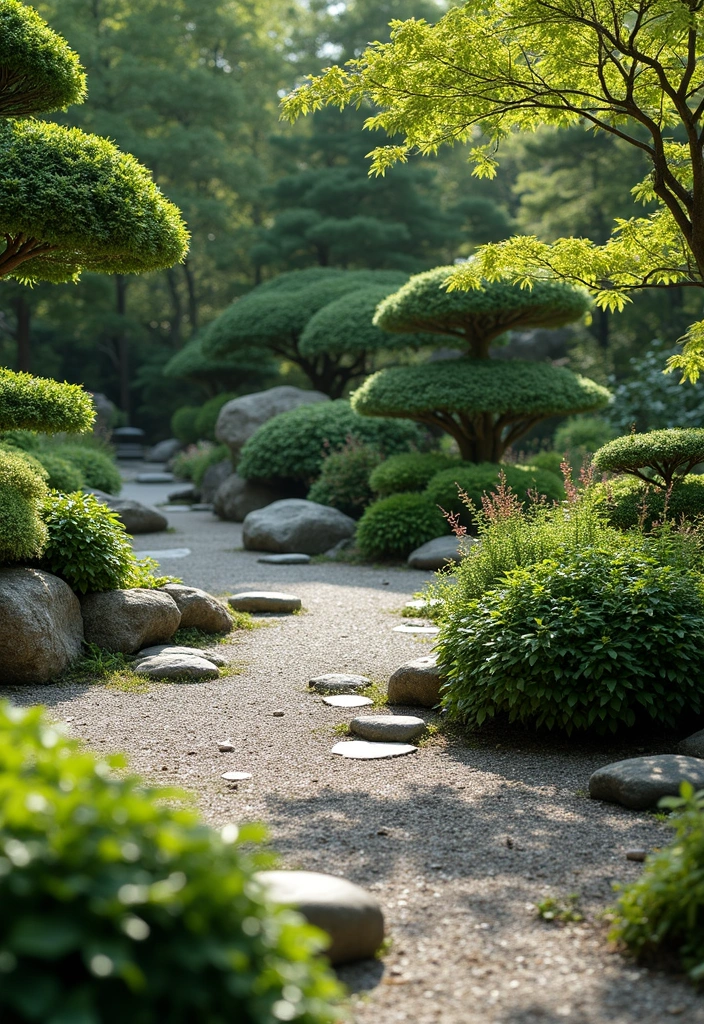
Sunken gardens can create the illusion of space in small areas, drawing the eye down and around. By lowering the garden bed slightly, you can create a unique feature that feels lush and full. To enhance the edges of your garden, consider using garden edging stones. These easy-to-install stones provide a decorative border that helps blend the elevated edges with the lower area, while also defining the shape of your sunken garden.
This technique not only adds depth but also allows for better drainage and soil management. Incorporate cascading plants like cascading plants (e.g., creeping thyme or sedum), which can flourish in the lowered area and spill gracefully over the edges, creating a flowing effect. This not only enhances the garden’s aesthetic but also promotes healthy growth.
Additionally, consider including a small seating area within the sunken garden to provide an intimate escape. An outdoor garden bench can be a perfect addition, allowing you to relax and enjoy the serene environment you’ve created.
Insights:
– Create a tiered effect with different plant heights.
– Ensure proper drainage to prevent waterlogging.
– Plant native species for easier maintenance and local wildlife support.
Sunken gardens can transform your compact space into a dramatic feature that invites exploration.
15. Raised Planters
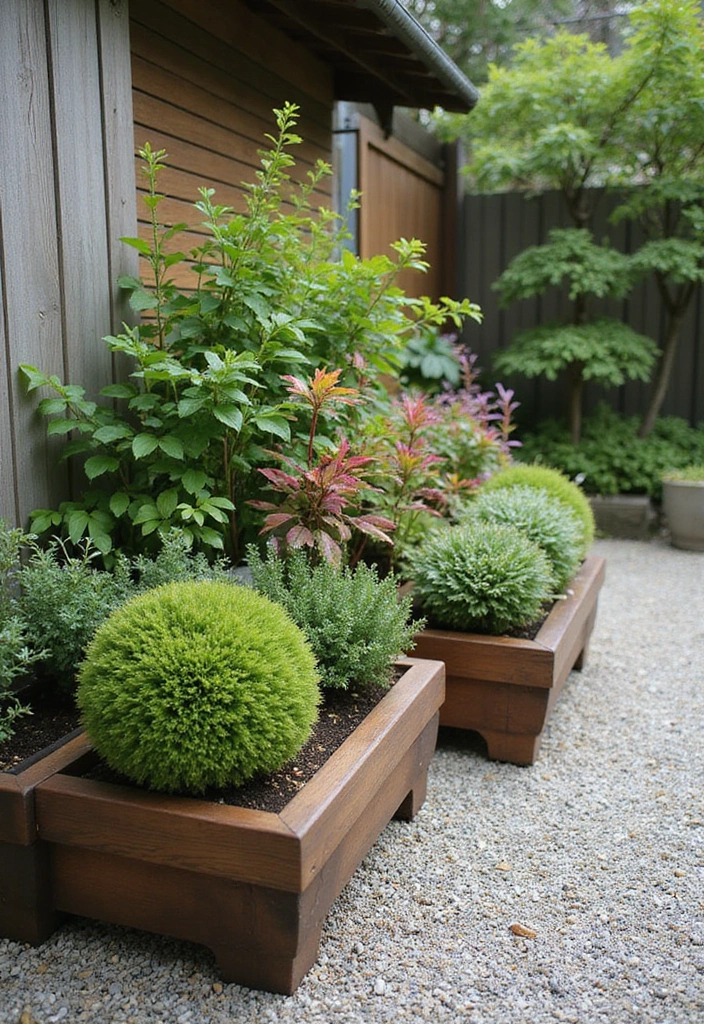
Raised planters can add visual interest and make it easier to tend to your plants. These can be built from wood or stone and positioned throughout your garden for an organized look. Use them to grow a variety of herbs, flowers, or even small trees that align with the Japanese aesthetic.
Creating raised beds not only elevates your plants but also keeps them off the ground, which can help with drainage and prevent pests. To achieve optimal drainage, consider using high-quality potting soil mix, which is suitable for container plants, flowers, and vegetables, ensuring your plants thrive. Additionally, you can arrange planters in a staggered formation to create a dynamic landscape. Add gravel or stepping stones around the planters for easy access.
To enhance the traditional look, line the edges of your planters with Japanese garden stones. These stones not only add to the aesthetic but also provide a cohesive appearance that complements the beauty of your garden. Regularly rotating the plants will allow for seasonal variety and keep your garden looking fresh.
With these elements in place, raised planters not only enhance aesthetics but also make gardening more accessible. For those looking for structure, consider the wooden raised garden bed kit to create a solid foundation for your plants.
16. Rock Gardens
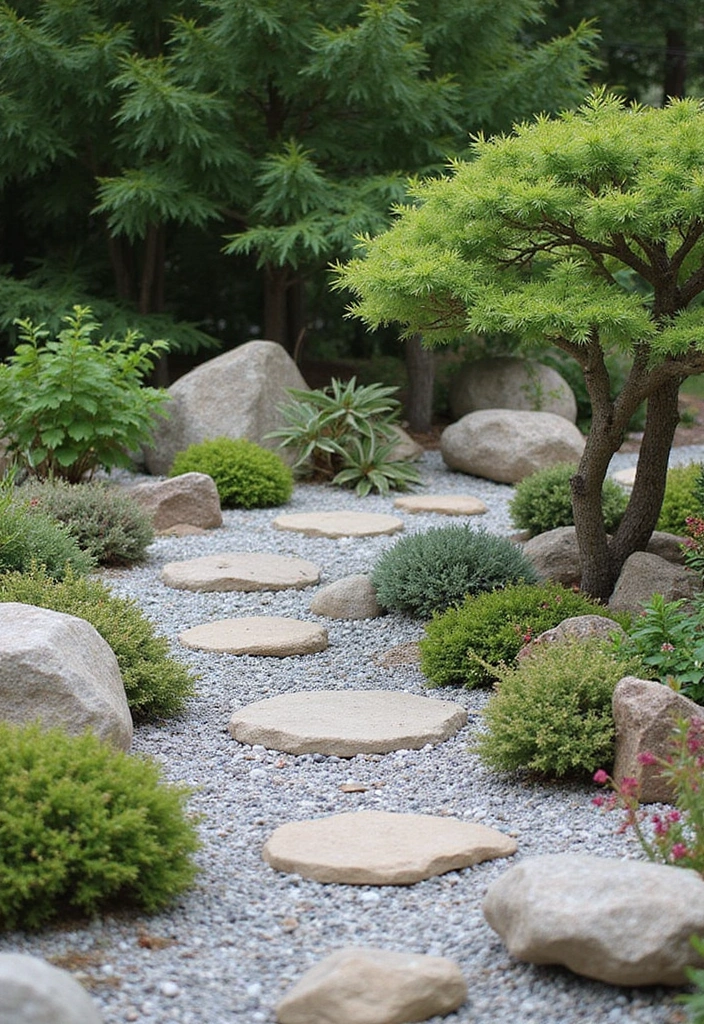
Rock gardens are an excellent way to integrate natural elements into your small garden. By carefully placing rocks and stones of different sizes, you can create a stunning visual that simulates a natural landscape. This design is not only visually appealing but also allows for low-maintenance gardening.
To enhance your rock garden, consider incorporating drought-tolerant plants like the succulent plant assortment, which includes a variety of potted succulents that thrive in rocky soil. Additionally, adding a small water feature or decorative gravel paths can elevate the look of your garden. The decorative gravel for landscaping not only provides an aesthetic appeal but also helps with drainage and erosion prevention.
Position larger rocks strategically to serve as focal points or borders within your garden. You might also consider using natural stone for rock gardens, like polished gemstones, to add unique touches that can enhance the overall texture and appearance.
Insights:
– Group rocks in odd numbers for a more organic feel.
– Use a variety of textures and colors for greater visual interest.
– Ensure good drainage to prevent erosion.
Rock gardens blend beauty with practicality, making them a fantastic feature for small spaces.
17. Garden Ornaments
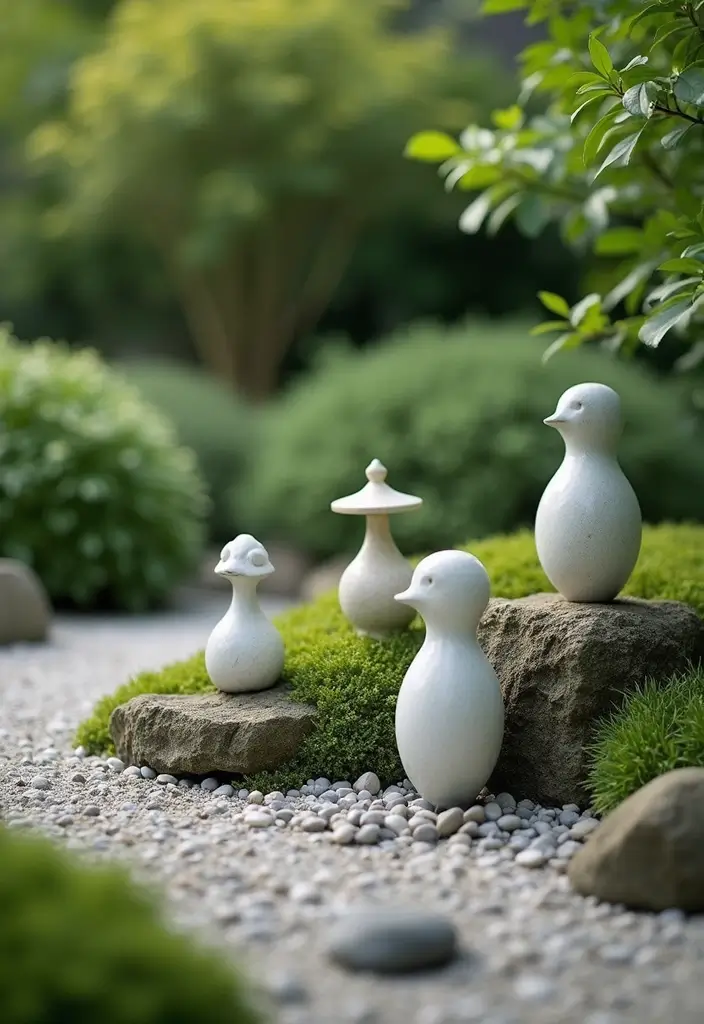
Adding garden ornaments like ceramic crane garden ornament, Buddha statues, or traditional lanterns can immediately elevate the ambiance of your small Japanese garden. These decorative elements add personality and charm, creating focal points that draw the eye. The Buddha statue for garden, for instance, serves as a serene centerpiece that embodies tranquility, perfect for a peaceful retreat. Choose items that resonate with your style while maintaining the simplicity of traditional Japanese design.
Position ornaments near paths, water features, or among plants to create visual layers. For example, a Japanese lantern garden light can illuminate your space at night while adding an elegant touch during the day. Always remember to keep the scale appropriate; too many large items can overwhelm a compact space. Consider the material and color of the ornaments too, opting for natural tones that blend well with the greenery.
Suggestions:
– Use ornaments that tell a story or reflect your interests.
– Keep them well maintained to ensure they shine in your garden.
– Balance the placement with plant life to maintain harmony.
Garden ornaments enhance personal expression while honoring the essence of Japanese aesthetics.
18. Gravel Gardens
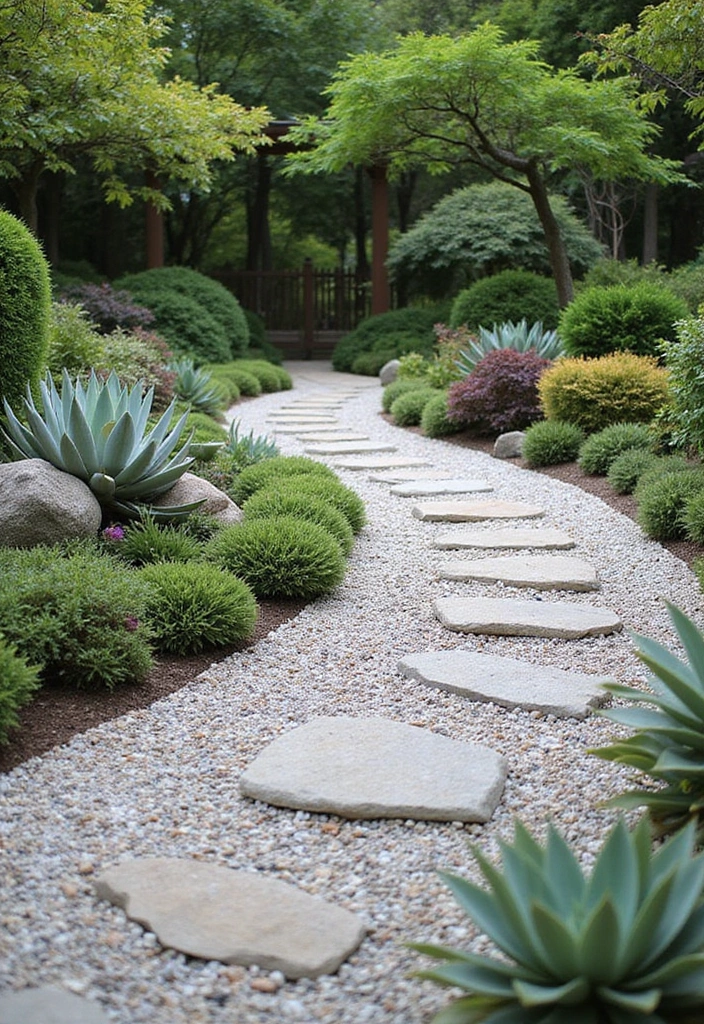
Gravel gardens are a fantastic low-maintenance option for small Japanese gardens, offering a clean, modern aesthetic. The use of gravel allows for good drainage and can be visually appealing when designed well. Choose dark or light gravel that complements your plants and stones for a harmonious look. For instance, consider using decorative gravel, which comes in a mix of natural polished stones and can enhance the overall look of your garden.
Incorporate succulents or other hardy plants to add life while keeping upkeep minimal. A great option is the succulent plant assortment, featuring a variety of live succulent plants that thrive in various conditions and can add vibrant greenery to your gravel landscape. Consider creative patterns with the gravel for visual interest, and use larger stones as accents. For this, natural stone accents can serve as excellent focal points, bringing contrast and texture to your design.
Gravel paths can guide visitors through the garden, inviting exploration. Regularly removing debris will keep the gravel looking fresh, while ensuring the gravel is deep enough will suppress weeds. Gravel gardens are not only practical but also provide a modern twist on traditional Japanese landscaping.
19. Seasonal Decorations
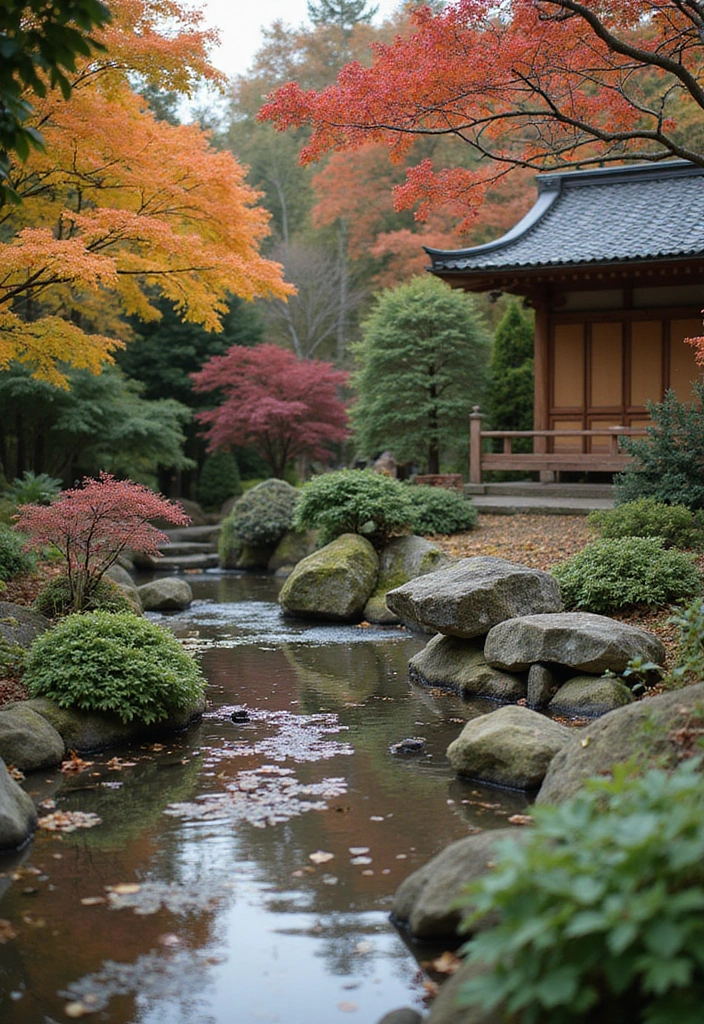
Incorporating seasonal decorations is a delightful way to keep your small Japanese garden vibrant and engaging throughout the year. By using elements like lanterns, colorful planters, or themed ornaments, you can reflect the current season beautifully. For instance, you might hang Japanese lanterns during summer festivals, adding a warm and inviting glow to your garden space.
To welcome spring, consider planting blooms in colorful planters that showcase a variety of vibrant flowers, embodying the lively spirit of cherry blossoms. In autumn, the rich colors of the foliage can be complemented with seasonal garden ornaments, like charming ceramic mushrooms, which can add a whimsical touch to your space.
These decorations not only beautify your garden but also serve as conversation starters, allowing you to share the significance of each element with visitors. It’s essential to ensure that the decorations maintain harmony with the natural elements of your garden, keeping the overall aesthetic intact. By rotating decorations every season, you can keep things fresh and exciting.
Suggestions:
– Store decorations properly to maintain their quality.
– Choose materials that weather well outdoors.
– Reflect on Japanese traditions when selecting seasonal themes.
Seasonal decorations breathe life into your garden, making it feel alive and ever-changing.
20. Container Gardening
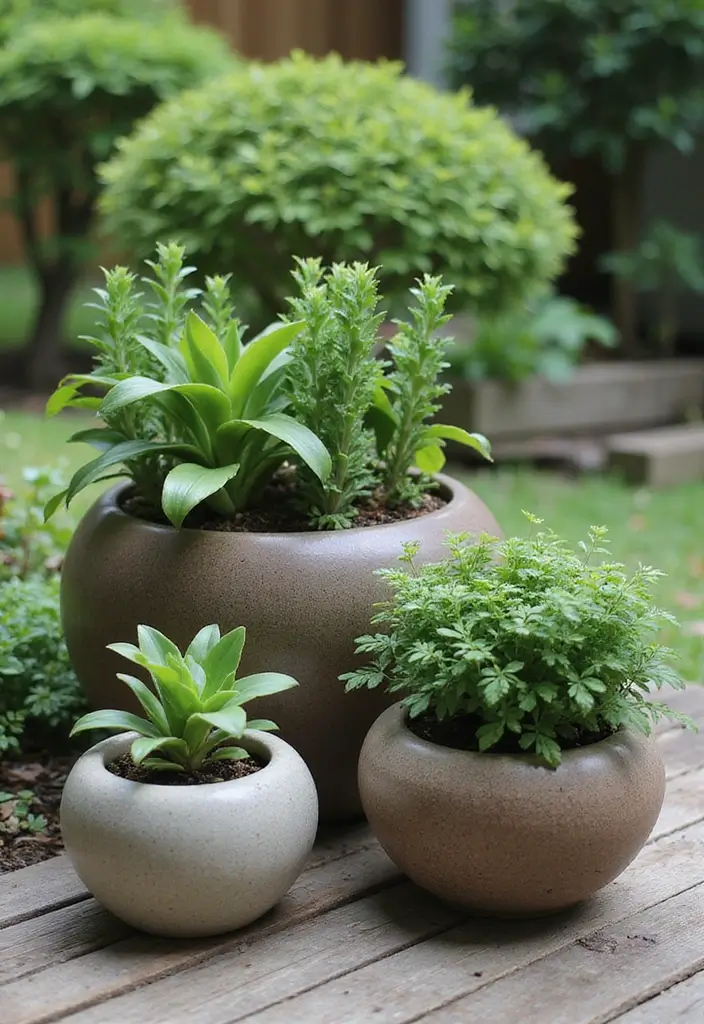
Container gardening is a practical solution for small spaces, allowing you to grow a variety of plants in pots strategically placed around your garden. This method makes it easier to manage and reconfigure your garden layout as needed. Choose pots that align with the Japanese aesthetic—think stone, ceramic, or rustic wood. For example, the ceramic planters from Gepege, featuring a drainage hole and saucer, are perfect for showcasing your favorite succulents or flowers.
Fill containers with herbs, flowers, or small trees, ensuring to combine plants with similar light and water needs. The right soil is crucial for container gardening; consider using potting soil mix by Miracle-Gro, which supports a variety of plants and feeds them for up to six months. This will help your plants thrive in their confined spaces.
Container gardens also allow for easy mobility; if you need to change the arrangement, you can do so effortlessly. Additionally, consider using decorative stones or gravel as a base layer in your containers for added drainage and style. The decorative gravel option made of natural polished stones is not only functional but also enhances the visual appeal of your arrangements.
Tips:
– Regularly check soil moisture levels as containers can dry out faster.
– Use potting soil that supports the specific plants you choose.
– Consider layering plants by height for a visually engaging display.
Container gardening enhances flexibility and creativity in your garden design.
21. Colorful Pathways
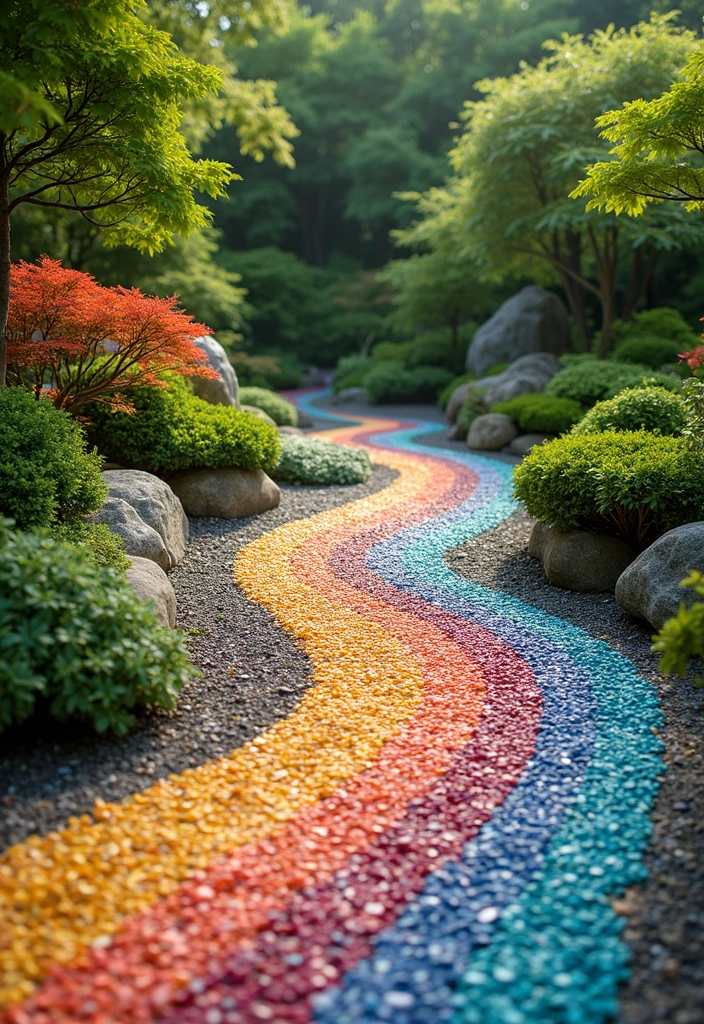
Colorful pathways can be a stunning addition to any small Japanese garden. Consider using colorful pebbles like colorful pebbles for garden pathways to create your own unique path that guides visitors through the garden. This playful approach can break up the monotony and introduce an artistic flair. Warm tones such as reds and oranges can create a lively atmosphere, while cooler tones offer a calming effect.
To ensure stability and durability, start with a base layer of gravel, such as gravel for garden path base layer. This will support the colorful pebbles or tiles and help prevent shifting over time. Choose materials that complement the natural elements of your garden, ensuring harmony with plants, stones, and water features. You can even create patterns with the stones to enhance visual interest.
For an aesthetically pleasing finish, you might consider utilizing outdoor garden tiles. These can add a touch of elegance while still being practical for outdoor use. Ensure paths are functional and easy to navigate, particularly if visitors will be walking through.
Insights:
– Regularly check for weeds in between stones or tiles.
– Use a base layer of gravel for stability.
– Balance colorful paths with neutral decor to keep the aesthetic cohesive.
Colorful pathways not only enhance navigation but also embody a unique artistic expression.
22. Seasonal Planting Guide
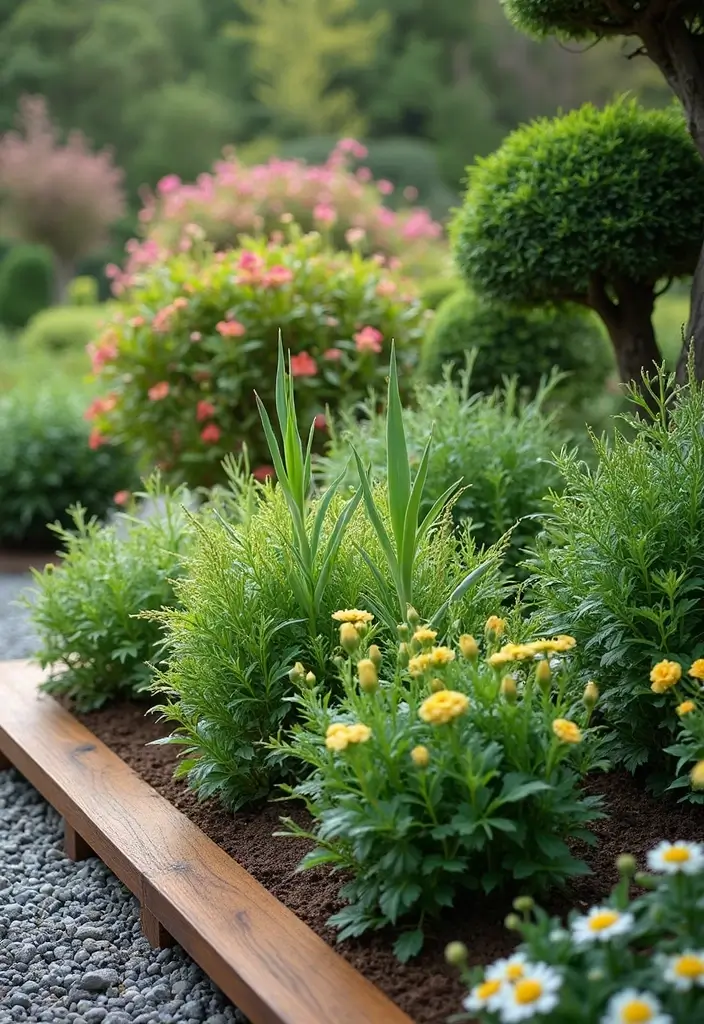
Creating a seasonal planting guide can be immensely beneficial for your small Japanese garden. Knowing when to plant, prune, and maintain your garden ensures that each season brings forth vibrant blooms and healthy plants. Spring is ideal for planting cherry blossoms and azaleas, while summer is perfect for irises.
Autumn can be a great time to plant chrysanthemums and ornamental grasses, while winter is suitable for pruning and preparing the garden for spring. To help keep track of your planting schedule, consider using a seasonal planting calendar. This tool can assist you in determining optimal times for gardening activities, leading to a flourishing garden year-round.
Additionally, maintaining your plants is crucial, and for that, a reliable pair of pruning shears is essential. The pruning shears will allow you to efficiently trim and shape your plants, promoting healthy growth as the seasons change.
To enhance your gardening experience, documenting your journey can be incredibly helpful. A garden planner journal can serve as a wonderful resource for tracking your progress and planning ahead, making your gardening efforts more structured and successful.
Having a planting guide, along with the right tools and resources, can transform your gardening experience into a rewarding endeavor. Don’t forget to utilize local gardening resources for species recommendations and consider attending workshops or gardening clubs for community support.
23. Garden Schedule
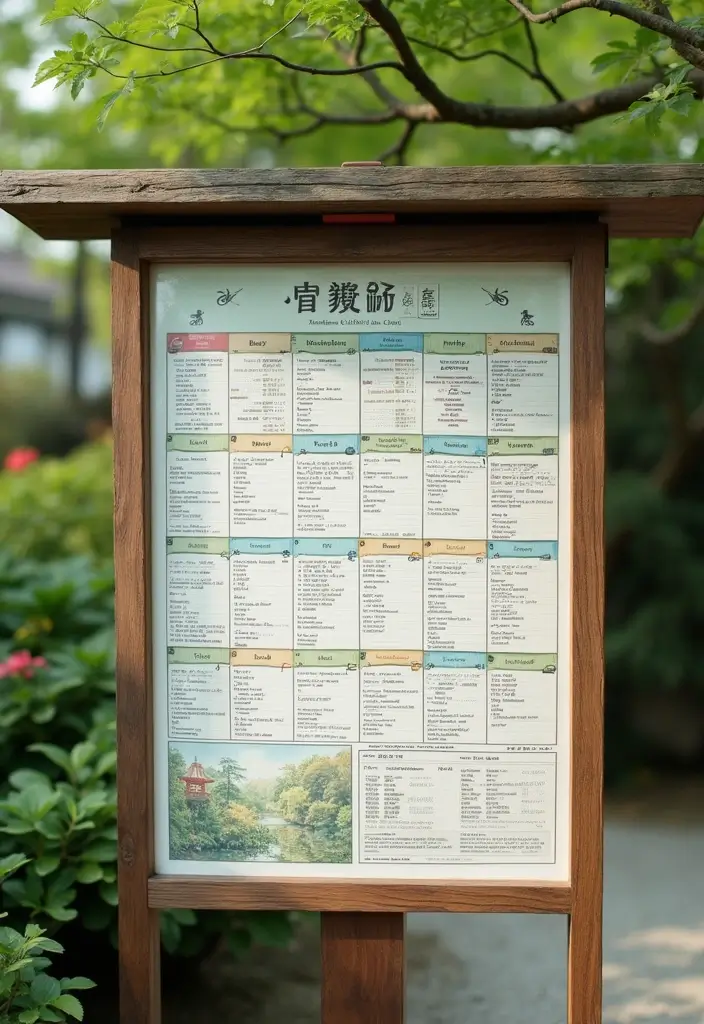
Maintaining a garden schedule is crucial for keeping your small Japanese garden thriving. This plan should include regular tasks like watering, weeding, fertilizing, and deadheading flowers. By establishing a routine, you can also create dedicated time for meditation and relaxation within your garden.
To help you stay organized, consider using a Garden Planner Journal. This handy tool allows you to outline your tasks and set their frequency, making it easier to manage your garden effectively. You can also integrate seasonal events, like flower blooms or harvesting, into your schedule to maximize your gardening experience.
For quick reminders, you might find a set of colorful plastic plant labels particularly useful. These T-type tags can help you keep track of what you’ve planted and when to expect blooms or produce. By labeling your plants, you’ll enhance organization and create a visually appealing space.
Tips:
– Set reminders on your phone or use a physical planner.
– Involve family or friends for fun group gardening sessions.
– Track your garden’s progress to celebrate successes.
A solid garden schedule can enhance your gardening experience and ensure every aspect is cared for properly.
24. Natural Stone Features
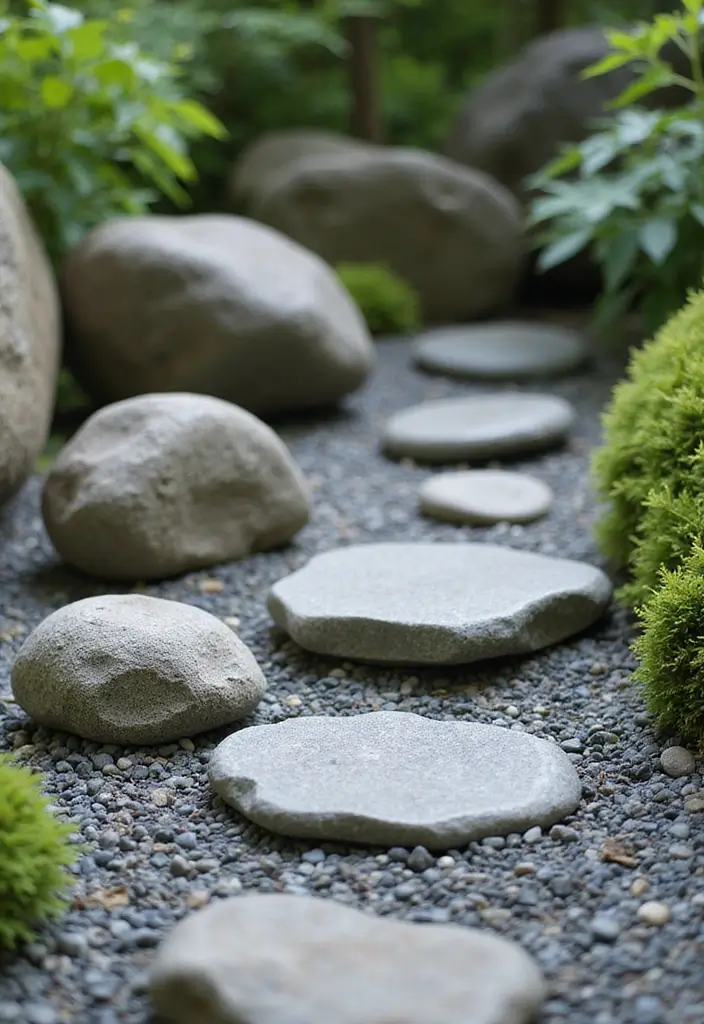
Natural stone features can bring a rustic elegance to your small garden. Incorporating stones as borders, seating areas, or even as part of your water features can enhance the overall aesthetic. The texture and varying colors of stones complement lush greenery beautifully. For an easy and effective way to create a polished look, consider using Natural Stone Garden Edging, which offers a decorative stone-look border that can help define garden areas while providing practicality.
Using local stones can further enhance the authenticity of your garden design. Arrange stones in natural formations to mimic the look of a hillside or streambed, which enhances the organic feel of your garden. Large boulders can serve as focal points, balanced with smaller stones for a cohesive look. For a decorative touch, consider adding Decorative River Rocks, which can add a splash of color and texture to your landscape.
This natural approach can also aid in drainage, providing practical benefits. When incorporating larger stones, ensure stability to maintain safety. Mixing stones of different shapes and sizes contributes to a more naturalistic appearance, and keeping pathways clear for accessibility is essential.
Finally, for a functional yet stylish seating option, consider a Garden Stone Bench. This piece not only complements your garden’s aesthetics but also offers a cozy spot to relax and enjoy your outdoor space.
Natural stone features can enhance your garden’s beauty while serving essential functions that improve both its appearance and usability.
25. Enclosed Spaces
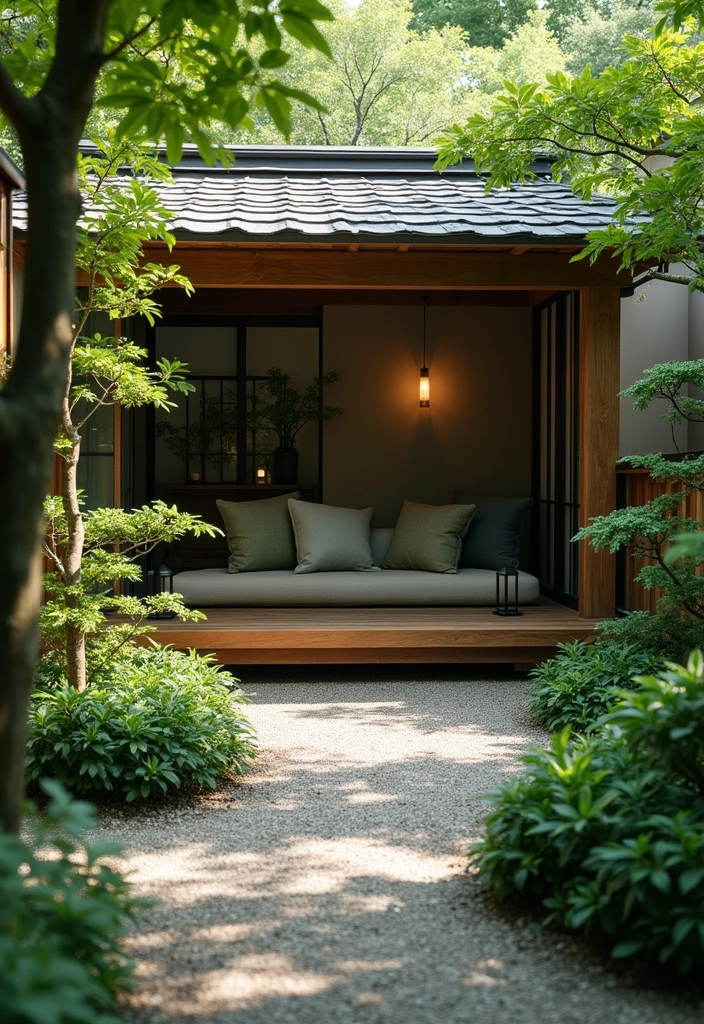
Creating enclosed spaces can enhance the tranquility of your Japanese garden. Use strategically placed plants, trellises, or even fencing to define areas within your garden. These sections can provide private spots for meditation, reading, or simply enjoying nature. Enclosed spaces also help shelter plants from wind and pests, creating a more serene environment.
For instance, consider incorporating a garden trellis that allows climbing plants like fragrant flowering vines to flourish, adding both beauty and scent to your enclosures. The blue moon wisteria vine is a wonderful choice, featuring massive foot-long fragrant flowers that attract hummingbirds and invite visitors to experience delightful aromas as they stroll through your garden.
Ensure pathways remain clear to allow for easy movement between these spaces. To further enhance your garden, consider adding an outdoor garden bench, providing a peaceful retreat where you can sit and enjoy the beauty around you.
Remember to use height variations to create visual interest in your enclosures, and balance open and enclosed areas for variety. Enclosed spaces create inviting nooks that enhance the peaceful experience of your garden.
26. Creative Lighting
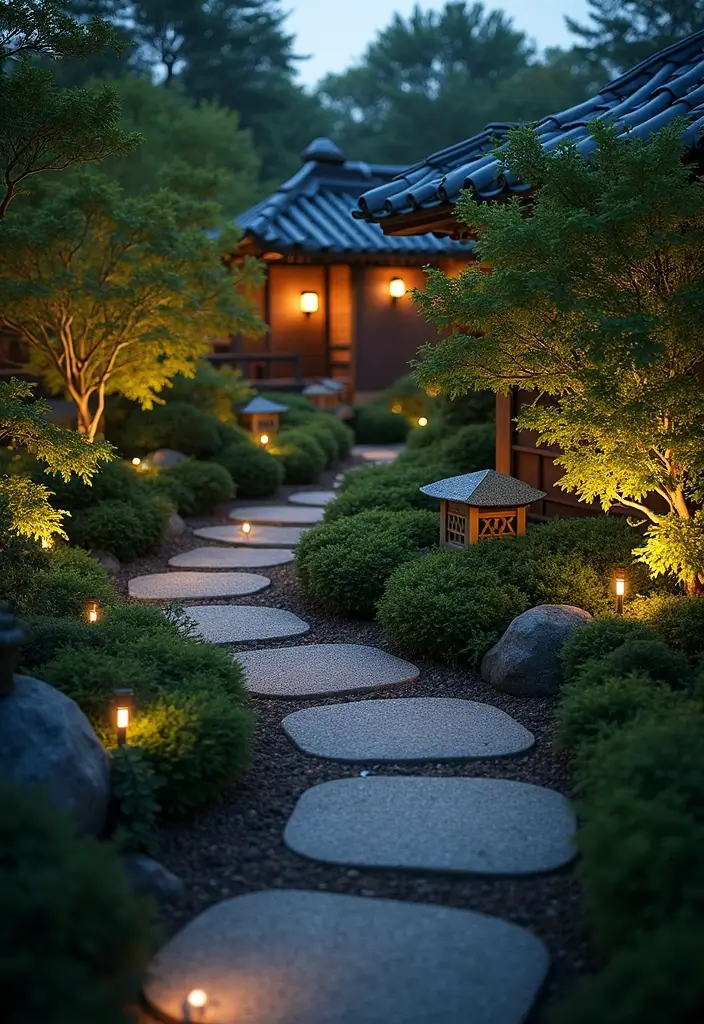
Incorporating creative lighting into your small Japanese garden can dramatically change the ambiance. Use soft, warm lights to highlight pathways, lanterns, or water features, creating a magical atmosphere in the evening. For an eco-friendly option, consider solar-powered garden lights. This 4-pack features 32 LEDs and is perfect for adding enchanting touches without the hassle of wiring.
To enhance the allure, try using uplighting to illuminate trees or shrubs, creating shadows that dance across the garden. The LED uplights can bring a vibrant glow to your outdoor space, making it ideal for evening gatherings or quiet reflection.
For a whimsical touch, hang some fairy string lights in the trees. These battery-operated lights add a charming starry effect, perfect for creating a cozy retreat.
Remember to keep the lights subtle and tasteful, aligning with the overall aesthetic of the space. Test different lighting placements to find the most appealing effect, and consider timers for added convenience. Focus on the areas you want to highlight without overwhelming the scene. Creative lighting not only enhances the beauty of your garden but also transforms it into a magical nighttime retreat.
Conclusion
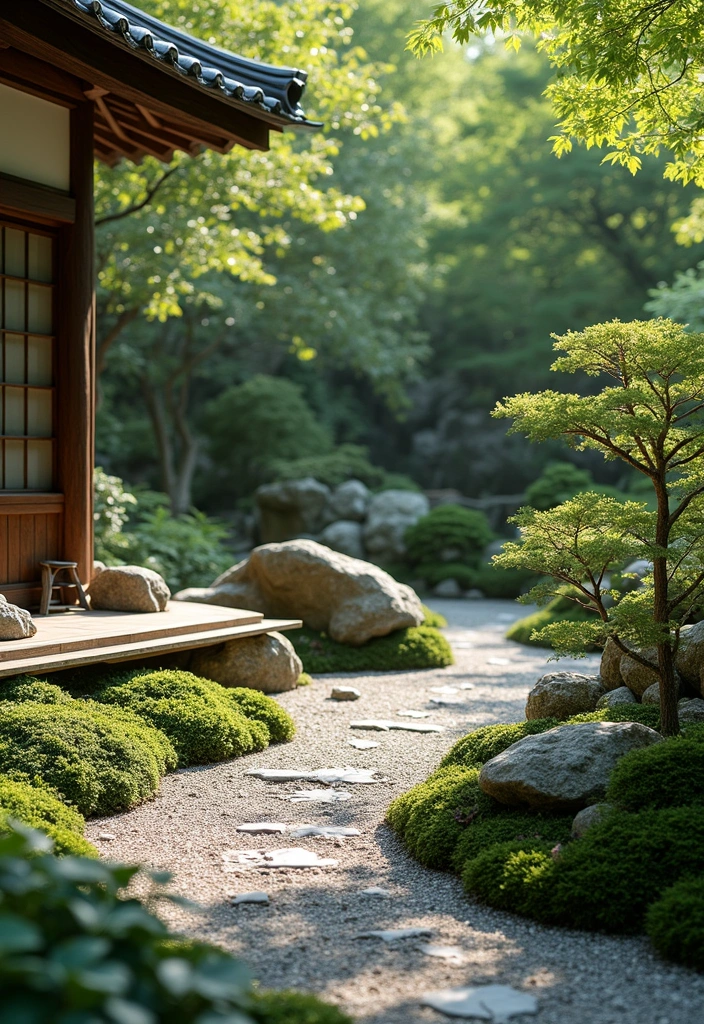
Embarking on the journey of creating a small Japanese garden is an enriching experience that brings tranquility and beauty into compact spaces. Each of the ideas shared here can be tailored to suit your preferences, making your garden a true reflection of your personality and your love for nature.
Whether you incorporate water features, vibrant plants, or cozy seating, each element plays a role in crafting a harmonious environment that invites relaxation and reflection. Dive into these ideas and start transforming your outdoor space into a serene oasis today!
Note: We aim to provide accurate product links, but some may occasionally expire or become unavailable. If this happens, please search directly on Amazon for the product or a suitable alternative.
This post contains Amazon affiliate links, meaning I may earn a small commission if you purchase through my links, at no extra cost to you.
Frequently Asked Questions
What are the essential elements of a small Japanese garden?
Creating a small Japanese garden involves incorporating essential elements like stone pathways, water features, and bamboo fencing. These elements not only enhance the aesthetic appeal but also promote a sense of tranquility and harmony within your compact outdoor space.
Remember to choose features that resonate with you, whether it’s a calming zen sand garden or a charming miniature koi pond, to create your personal oasis.
How do I maintain my small Japanese garden throughout the seasons?
Maintaining your small Japanese garden requires a well-planned garden schedule. Regular tasks include watering, pruning, and deadheading flowers to keep your plants healthy and vibrant. Implementing a seasonal planting guide can help ensure that you have blooming flowers and lush greenery year-round. Don’t forget to adjust your care routine as the seasons change to keep your garden thriving!
What are some low-maintenance plants ideal for a small Japanese garden?
If you’re looking for low-maintenance plants for your small Japanese garden, consider incorporating moss, Japanese maples, and pruned bonsai trees. Moss provides a lush carpet that requires minimal upkeep, while Japanese maples add stunning color with their changing foliage. Bonsai trees are not only beautiful but also add an element of artistry to your garden without demanding too much attention.
Can I create a small Japanese garden in a container?
Absolutely! Container gardening is a fantastic way to create a small Japanese garden, especially in limited spaces. Use decorative pots to grow a variety of plants, including seasonal flowers and miniature trees. This method allows for flexibility in design and easy rearrangement, helping you to maintain a beautiful and serene garden atmosphere in your compact outdoor space.
How can I incorporate water features into my small Japanese garden?
Incorporating water features into your small Japanese garden can enhance its tranquility and beauty. Consider adding a miniature koi pond, a small waterfall, or even a simple birdbath. These elements not only provide soothing sounds but also attract wildlife, creating a vibrant ecosystem. Be sure to choose designs that fit your space, ensuring that they complement the overall theme of your garden.
Related Topics

